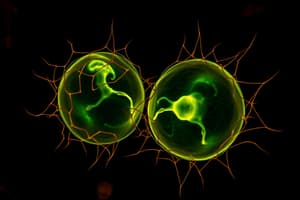Podcast
Questions and Answers
Relaciona las fases de la mitosis con sus descripciones correspondientes:
Relaciona las fases de la mitosis con sus descripciones correspondientes:
Profase = Los cromosomas se condensan y se alinean en el centro de la célula Metafase = Los cromosomas se separan hacia los extremos opuestos de la célula Anafase = Los cromosomas se dividen y son arrastrados hacia los polos celulares Telofase = Se forma una placa de metafase con los cromosomas alineados en el centro
Relaciona los propósitos principales de la mitosis y la meiosis con sus descripciones correspondientes:
Relaciona los propósitos principales de la mitosis y la meiosis con sus descripciones correspondientes:
Mitosis = Resulta en dos células hijas genéticamente idénticas a la célula madre Meiosis = Reduce a la mitad tanto el número de cromosomas como la información genética
Relaciona los tipos de células resultantes de la mitosis y la meiosis con sus descripciones correspondientes:
Relaciona los tipos de células resultantes de la mitosis y la meiosis con sus descripciones correspondientes:
Mitosis = Importante para el mantenimiento de tejidos en organismos multicelulares Meiosis = Ocurre durante la diferenciación de células germinales para formar gametos
Relaciona los procesos de replicación del ADN con las etapas del ciclo celular:
Relaciona los procesos de replicación del ADN con las etapas del ciclo celular:
Relaciona los conceptos de segregación cromosómica con los tipos de división celular:
Relaciona los conceptos de segregación cromosómica con los tipos de división celular:
Relaciona los siguientes términos con su descripción correspondiente:
Relaciona los siguientes términos con su descripción correspondiente:
Empareja los siguientes procesos con su descripción correspondiente:
Empareja los siguientes procesos con su descripción correspondiente:
Relaciona los siguientes conceptos con su explicación correspondiente:
Relaciona los siguientes conceptos con su explicación correspondiente:
Asocia los siguientes términos con su definición correspondiente:
Asocia los siguientes términos con su definición correspondiente:
Vincula los siguientes términos con su descripción correspondiente:
Vincula los siguientes términos con su descripción correspondiente:
Flashcards are hidden until you start studying
Study Notes
An Overview of Cellular Reproduction
Cellular reproduction is a vital process in maintaining life and ensuring the continuation of species. There are two primary methods of cellular reproduction: mitosis and meiosis. Both processes involve the separation of chromosomates, DNA replication, and the formation of new cells.
Mitosis
Mitosis is a type of cell division that results in the formation of two genetically identical daughter cells from a single parent cell. This process is crucial for growth, development, and tissue maintenance in multicellular organisms. Mitosis is composed of five distinct phases: prophase, prometaphase, metaphase, anaphase, and telophase. During mitosis, the chromosomes condense and align at the center of the cell, known as the metaphase plate. Then, the chromosomes are pulled apart evenly towards the opposing ends of the cell, resulting in two identical sets of chromosomes in the daughter cells.
Meiosis
Meiosis, on the other hand, is a specialized form of cell division that occurs during germ cell differentiation to produce haploid cells. Unlike mitosis, meiosis undergoes two rounds of cell division, which halves both the number of chromosomes and their genetic information. This process leads to the formation of four haploid cells with unique sets of genetic material. Each set consists of half the chromosomes compared to the original diploid cell. The haploid cells formed through meiosis are called sex cells (sperm or egg). After fertilization, the resulting zygote develops into a new organism, starting another cycle of life.
Cell Cycle Regulation
The regulation of cellular reproduction is crucial for maintaining healthy tissues and organs. The cell cycle, including DNA replication and cell division, is controlled by various mechanisms that ensure accurate and timely completion of these processes. These regulatory mechanisms include protein complexes and biochemical interactions that either promote or inhibit the progression of the cell cycle.
Chromosome Segregation
Chromosome segregation is a critical aspect of cellular reproduction, as it ensures equal distribution of genetic material between daughter cells. During mitosis and meiosis, chromosomes condense and align at the metaphase plate, where they are attached to spindle fibers from microtubules. The pull of these fibers then separates sister chromatids or homologous pairs of chromosomes, leading to the formation of two genetically identical daughter cells (mitosis) or four genetically diverse cells (meiosis).
DNA Replication
Before a cell can undergo division, it must duplicate its entire genetic material encoded in DNA strands. DNA replication is an essential step in ensuring that each new cell has the same genetic makeup as the parent cell. It involves the initiation of DNA unwinding and separation, followed by the synthesis of complementary nucleotides along the template strand. Once both strands have been fully duplicated, the resulting double helix structures separate, allowing the newly synthesized DNA strands to be incorporated into the daughter cells during mitosis or meiosis.
Studying That Suits You
Use AI to generate personalized quizzes and flashcards to suit your learning preferences.




